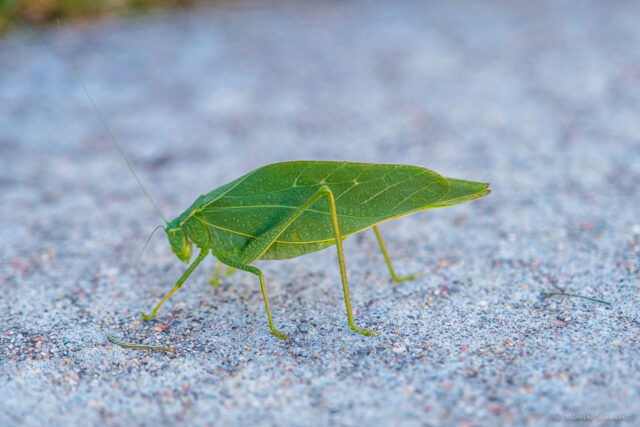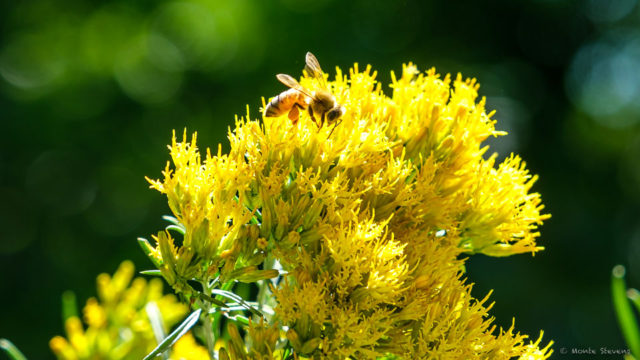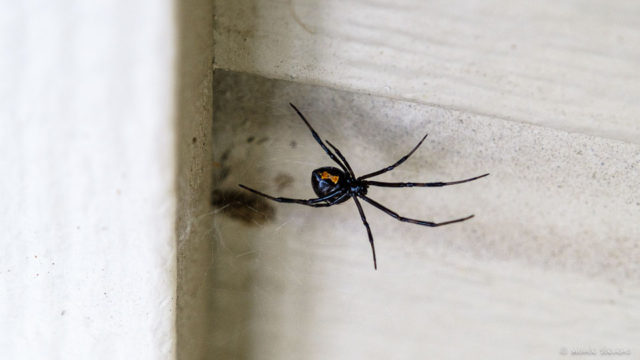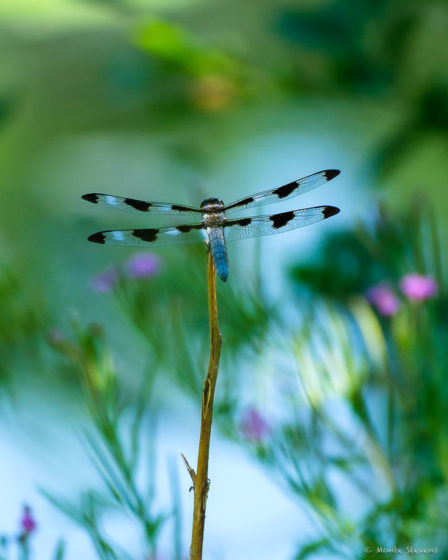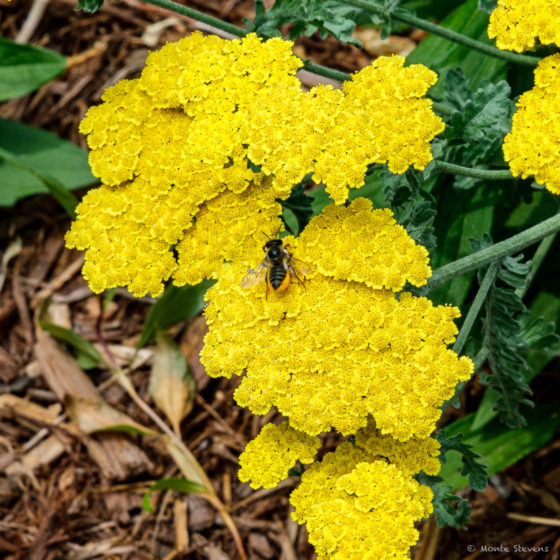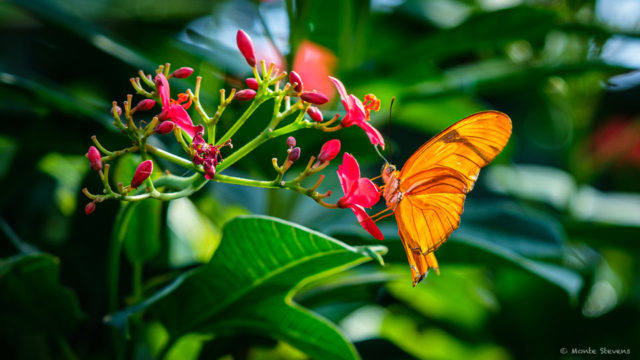I think this is the leaf katydid which is widely distributed in Colorado, found in both eastern and western Colorado and also common in many urban areas. They are related to crickets and grasshoppers. It is one of the most often heard Colorado insects, making clicking calls in trees and shrubs during late summer. They make the noise by rubbing a hind leg on one wing, similar to cícadas, and use it to attract the ladies. I knew they existed as I hear them quite often in the evening but seldom see them. Anyway, this one was on the sidewalk outside my door late Saturday afternoon. And, they were quiet. I almost stepped on it.
-
-
Pollen Laden Bee
Rubber rabbitbrush occurs in the cold deserts of the Colorado Plateau, throughout much of the Great Basin, and in warm deserts of the Southwest from lower-elevation Sonoran to subalpine zones. Rubber rabbitbrush favors sunny, open sites throughout a wide variety of habitats including open plains, valleys, drainage ways, foothills, and mountains. It is particularly common on disturbed sites. Rubber rabbitbrush is cold hardy, and tolerant of both moisture and salt stress. There are several plants along the edge of my ponds between the grass and pond. They attract a wide array of native insects, including butterflies and small bees. It is one the few native plant species in the Intermountain West that provides habitat for pollinators during the late summer and fall months. Love the bright colored yellow that makes them stand out. In general, wildlife and livestock forage only lightly on this species during the summer, but winter use can be heavy in some locations. Fall use is variable, but flowers are often used by wildlife and livestock. A few leaves and the more tender stems may also be used. Surprisingly rabbits seldom dine on them except in winter but love to hide in them.
-
Who’s Watching Who
meandering gently through the meadow
ms
along the water’s edge
being present to all that’s around me
encountering this wasp on a milkweed leaf
sharing this world with them and
wondering, who’s watching who -
Creepy
I discovered this unwanted visitor near my front door. I would say she is about 3/4 inch long. Even at that length they are a danger and creepy. I was able to get a few photos before I quickly ended her life. Of course this caused me to do some research on these creatures of darkness and myth. They belong to a group known as cobweb spiders. Black widows get their common name from the popular belief that the female eats the male after mating, a phenomenon which rarely happens in nature. I’m sure that’s reassuring for any male black widow spider. Black widow venom is reported to be 15 times stronger than a rattlesnake’s, but because spiders deliver far less venom than snakes do, their bites — though painful — are a serious risk only to the very young and the very old. I place myself in the old category. Although I do not like spiders, I do not bother them, seldom killing them and aware they are a part of this world. They have a role of predator as well as prey. I did not like the fact that this gal was at my front door so that’s why I killed her. Then after I killed her my mind began to wonder: Where are the others? Did they see me kill her? Will they want revenge? Creepy to me!
-
A Sense of Wonder
“We will recover our sense of wonder and our sense of the sacred only if we appreciate the universe beyond ourselves as a revelatory experience of that numinous presence whence all things come into being. Indeed, the universe is the primary sacred reality. We become sacred by our participation in this more sublime dimension of the world about us.”
Thomas BerryDragonflies hang around my ponds this time of the year. I really don’t know them that well but planning to change that. I do not have many images because they are such an elusive creature who needs patience to photograph. As I watched them over the weekend, I decided to set up my tripod and wait. I quickly began to sweat while standing in the 96 degree sun but I was determined. They skim and dart across the water with vigor at 22–34 mph.
The twelve-spotted skimmer, which I think this is, has twelve dark brown wing spots, three on each wing. Males have eight additional spots that are white. Dragonflies are predatory insects. The hunting behavior of adult dragonflies is called “hawking.” Their legs are held in a basket shape during flight, which is perfect for grasping mosquitoes and other small flying insects. Many Native American tribes consider dragonflies to be medicine animals that had special powers. For example, the southwestern tribes, including the Pueblo, Hopi, and Zuni, associated dragonflies with transformation. So today I watched and learned a lot about dragonflies. From now on I will look at them with different eyes, more respect and appreciation. I fell in love with this sacred creature, who I now know is my mosquito eating neighbor.
-
It’s interesting…
The inner spirit is who I really am. My body is alive in this nature and exists in its frame. I do not need to be spiritual to find this. I only need to stop believing that the ego, the small self, is me. If I do, a different knowing emerges which has a largeness and a certain beauty. It is an expression of power and love beyond the usual definitions. To live in its knowledge is to know yourself to be free.
from A NEW SET OF EYES by Paula D’ArcyThis is fern-leaf yarrow, and is an upright, clump-forming yarrow that is native to the Caucasus, Iran and Afghanistan and is in the sunflower family. Interestingly one name listed for them is nosebleed. (?) It is considered an invasive species by some states in the US. And, man is still not on that list. I find these plants in almost every natural area I visit. I really like how they look and the pollinators seem to like them also, as you can see with the heavily laden bee in this image.
I’m in a place in life where I resonate with the above quote. This process of uncovering who I really am, this knowing who I am, is exciting and freeing. Interesting that this bee does not consider what political party to belong to, what church to attend, what it’s favorite band is this week, and the other stuff we place in our lives. It lives in the knowledge of what it is and the life it is meant to live. It is free!
It’s interesting that I have used the word interesting three times in this post. Now four.
-
Courage
“Courage is the measure of our heartfelt participation with life, with another, with a community, a work; a future. To be courageous is not necessarily to go anywhere or do anything except to make conscious those things we already feel deeply and then to live through the unending vulnerabilities of those consequences.”
David Whyte -
Purdy Flowers and a Bee or Two
[ngg src=”galleries” ids=”80″ display=”basic_slideshow”]Wandered about the CSU Flower Trial Garden. Even though it’s near the end of the season for them it was a good way to spend a warm sunny fall afternoon.
